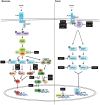Killing two birds with one stone: trans-kingdom suppression of PAMP/MAMP-induced immunity by T3E from enteropathogenic bacteria
- PMID: 25101059
- PMCID: PMC4105635
- DOI: 10.3389/fmicb.2014.00320
Killing two birds with one stone: trans-kingdom suppression of PAMP/MAMP-induced immunity by T3E from enteropathogenic bacteria
Abstract
Within the past decade, remarkable similarities between the molecular organization of animal and plant systems for non-self discrimination were revealed. Obvious parallels exist between the molecular structures of the receptors mediating the recognition of pathogen- or microbe-associated molecular patterns (PAMPs/MAMPs) with plant pattern recognition receptors strikingly resembling mammalian Toll-like receptors. Mitogen-activated protein kinase cascades, leading to the transcriptional activation of immunity-associated genes, illustrate the conservation of whole molecular building blocks of PAMP/MAMP-induced signaling. Enteropathogenic Salmonella and Escherichia coli use a type three secretion system (T3SS) to inject effector proteins into the mammalian host cell to subvert defense mechanisms and promote gut infection. Lately, disease occurrence was increasingly associated with bacteria-contaminated fruits and vegetables and common themes have emerged with regard to whether and how effectors target innate immune responses in a trans-kingdom manner. We propose that numerous Salmonella or E. coli effectors may be active in planta and tend to target central components (hubs) of immune signaling pathways.
Keywords: Escherichia coli; PAMP/MAMP; Salmonella; enteropathogenic bacteria; innate immunity; mammals; plants; type three effectors.
Figures

Similar articles
-
Innate immunity in plants and animals: striking similarities and obvious differences.Immunol Rev. 2004 Apr;198:249-66. doi: 10.1111/j.0105-2896.2004.0119.x. Immunol Rev. 2004. PMID: 15199967 Review.
-
Salmonella enterica induces and subverts the plant immune system.Front Microbiol. 2014 Apr 4;5:141. doi: 10.3389/fmicb.2014.00141. eCollection 2014. Front Microbiol. 2014. PMID: 24772109 Free PMC article. Review.
-
Plant immunity directly or indirectly restricts the injection of type III effectors by the Pseudomonas syringae type III secretion system.Plant Physiol. 2010 Sep;154(1):233-44. doi: 10.1104/pp.110.159723. Epub 2010 Jul 12. Plant Physiol. 2010. PMID: 20624999 Free PMC article.
-
Elicitation and suppression of microbe-associated molecular pattern-triggered immunity in plant-microbe interactions.Cell Microbiol. 2007 Jun;9(6):1385-96. doi: 10.1111/j.1462-5822.2007.00944.x. Epub 2007 Apr 19. Cell Microbiol. 2007. PMID: 17451411 Review.
-
Pattern recognition receptors and their interactions with bacterial type III effectors in plants.Genes Genomics. 2019 May;41(5):499-506. doi: 10.1007/s13258-019-00801-1. Epub 2019 Mar 4. Genes Genomics. 2019. PMID: 30830683 Review.
Cited by
-
Immune Sensing of Lipopolysaccharide in Plants and Animals: Same but Different.PLoS Pathog. 2016 Jun 9;12(6):e1005596. doi: 10.1371/journal.ppat.1005596. eCollection 2016 Jun. PLoS Pathog. 2016. PMID: 27281177 Free PMC article. Review. No abstract available.
-
Editorial on plants as alternative hosts for human and animal pathogens.Front Microbiol. 2015 Apr 30;6:397. doi: 10.3389/fmicb.2015.00397. eCollection 2015. Front Microbiol. 2015. PMID: 25983729 Free PMC article. No abstract available.
-
Interactions of Salmonella with animals and plants.Front Microbiol. 2015 Jan 21;5:791. doi: 10.3389/fmicb.2014.00791. eCollection 2014. Front Microbiol. 2015. PMID: 25653644 Free PMC article. Review.
-
Updating osteoimmunology: regulation of bone cells by innate and adaptive immunity.Nat Rev Rheumatol. 2018 Mar;14(3):146-156. doi: 10.1038/nrrheum.2017.213. Epub 2018 Jan 11. Nat Rev Rheumatol. 2018. PMID: 29323344 Free PMC article. Review.
-
Green Technology: Bacteria-Based Approach Could Lead to Unsuspected Microbe⁻Plant⁻Animal Interactions.Microorganisms. 2019 Feb 6;7(2):44. doi: 10.3390/microorganisms7020044. Microorganisms. 2019. PMID: 30736387 Free PMC article. Review.
References
Publication types
LinkOut - more resources
Full Text Sources
Other Literature Sources
Miscellaneous

